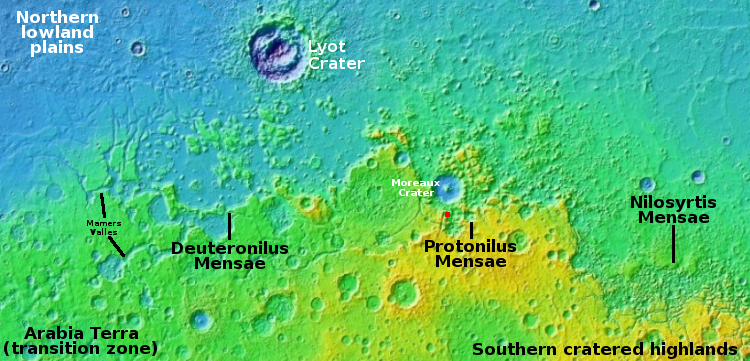A glacial river on Mars
Cool image time! The picture to the right, cropped, reduced, and sharpened to post here, was taken on November 1, 2022 by the high resolution camera on Mars Reconnaissance Orbiter (MRO). It shows a wonderful example of a glacier-filled canyon on Mars, the ice apparently flowing both along and around mesas as it carves its way downhill.
I think the downhill grade here is to the north, but this could be wrong for the two side canyons on the main canyon’s north side.
Not only is the material in the canyon likely ice, covered with a protective layer of trapped dust and ash that makes the glacier surface look so smooth, the mesa tops are likely impregnated with ice as well. The mesas however have little dust, so the plateaus have a mottled stippled look likely caused by sublimation of that underground ice.
The location of these canyons explains the presence of ice.

The red dot just south of 86-mile-wide Moreaux Crater marks the location of the canyons. This is dead center inside the 2,000-mile-long mid-latitude strip I dub glacier country. Almost every image produced by MRO shows glacier features, either flowing down the slopes of mesas or flowing along canyon floors.
The smoothness of the surface of the glacier inside the canyon is the most puzzling aspect of this picture. As I noted, this is likely caused by dust blown into the canyon by the wind, and then trapped there. Why it is so smooth however is baffling, as in other places trapped dust would form wind-blown ripples, none of which are seen here.
On Christmas Eve 1968 three Americans became the first humans to visit another world. What they did to celebrate was unexpected and profound, and will be remembered throughout all human history. Genesis: the Story of Apollo 8, Robert Zimmerman's classic history of humanity's first journey to another world, tells that story, and it is now available as both an ebook and an audiobook, both with a foreword by Valerie Anders and a new introduction by Robert Zimmerman.
The print edition can be purchased at Amazon or from any other book seller. If you want an autographed copy the price is $60 for the hardback and $45 for the paperback, plus $8 shipping for each. Go here for purchasing details. The ebook is available everywhere for $5.99 (before discount) at amazon, or direct from my ebook publisher, ebookit. If you buy it from ebookit you don't support the big tech companies and the author gets a bigger cut much sooner.
The audiobook is also available at all these vendors, and is also free with a 30-day trial membership to Audible.
"Not simply about one mission, [Genesis] is also the history of America's quest for the moon... Zimmerman has done a masterful job of tying disparate events together into a solid account of one of America's greatest human triumphs."--San Antonio Express-News
Cool image time! The picture to the right, cropped, reduced, and sharpened to post here, was taken on November 1, 2022 by the high resolution camera on Mars Reconnaissance Orbiter (MRO). It shows a wonderful example of a glacier-filled canyon on Mars, the ice apparently flowing both along and around mesas as it carves its way downhill.
I think the downhill grade here is to the north, but this could be wrong for the two side canyons on the main canyon’s north side.
Not only is the material in the canyon likely ice, covered with a protective layer of trapped dust and ash that makes the glacier surface look so smooth, the mesa tops are likely impregnated with ice as well. The mesas however have little dust, so the plateaus have a mottled stippled look likely caused by sublimation of that underground ice.
The location of these canyons explains the presence of ice.

The red dot just south of 86-mile-wide Moreaux Crater marks the location of the canyons. This is dead center inside the 2,000-mile-long mid-latitude strip I dub glacier country. Almost every image produced by MRO shows glacier features, either flowing down the slopes of mesas or flowing along canyon floors.
The smoothness of the surface of the glacier inside the canyon is the most puzzling aspect of this picture. As I noted, this is likely caused by dust blown into the canyon by the wind, and then trapped there. Why it is so smooth however is baffling, as in other places trapped dust would form wind-blown ripples, none of which are seen here.
On Christmas Eve 1968 three Americans became the first humans to visit another world. What they did to celebrate was unexpected and profound, and will be remembered throughout all human history. Genesis: the Story of Apollo 8, Robert Zimmerman's classic history of humanity's first journey to another world, tells that story, and it is now available as both an ebook and an audiobook, both with a foreword by Valerie Anders and a new introduction by Robert Zimmerman.
The print edition can be purchased at Amazon or from any other book seller. If you want an autographed copy the price is $60 for the hardback and $45 for the paperback, plus $8 shipping for each. Go here for purchasing details. The ebook is available everywhere for $5.99 (before discount) at amazon, or direct from my ebook publisher, ebookit. If you buy it from ebookit you don't support the big tech companies and the author gets a bigger cut much sooner.
The audiobook is also available at all these vendors, and is also free with a 30-day trial membership to Audible.
"Not simply about one mission, [Genesis] is also the history of America's quest for the moon... Zimmerman has done a masterful job of tying disparate events together into a solid account of one of America's greatest human triumphs."--San Antonio Express-News


